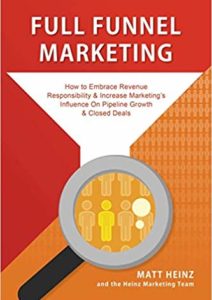Sales and marketing alignment is a much talked about problem, yet remains persistent in the sales world. This is at a detriment to many companies and organizations. As Matt Heinz, interviewed by John Golden, points out, there are tremendous benefits to unifying the sales and marketing teams.
This expert sales interview explores the importance of sales and marketing alignment, including:
- Why there is a separation in the first place
- How transparency can fix the problem
- The importance of mutual understanding
Why the Separation?
In most companies, sales and marketing are on different planes and have different objectives. “As a marketer, I believe this is mostly marketing’s fault,” said Heinz. “We as marketers have not embraced a level of revenue responsibility that sales have always had. You can’t buy a beer with a marketing qualified lead.” For this process of alignment to occur, a cultural shift is needed. “More marketing leaders need to be willing to step up to the plate,” said Heinz. It doesn’t help that historically, these two sectors have been very different and had very different jobs. The challenge and need for change have come about as a result of the change in the market, and a change in the needs of the buyer.
The Importance of Transparency:
One thing I think you have to have, as a marketing organization, is better empathy and transparency for what the organization requires,” said Heinz. You have to be comfortable managing objectives that you don’t have complete control over. After all, the sales team has never had control over hitting their number entirely. Being comfortable with change is necessary. “Having a level of transparency and flexibility and empathy across the organization is difficult if you haven’t done it before,” said Heinz. “But, you don’t have a choice if we expect marketing to be a contributor to the metrics that really matter.”
Mutual Understanding
To promote this unity between sales and marketing, it’s essential that each team share an understanding of what the other side is doing. For marketers, it’s understanding that their objective actually is sales, they are aiming for a revenue number. Also, marketing could help the unity by understanding the job of the sales reps. Equally, salespeople need to step into in marketing’s shoes. Many salespeople don’t realize how difficult marketing is today when you’re trying to get someone’s attention while 18,000 other companies are pulling for their attention as well. “Both jobs are really hard, and getting harder,” said Heinz.
The Benefit of Understanding
Understand what the other side is going through, and understand that it’s not going to be perfect, but that there is no other choice but to make things work. The integration of marketing and sales objectives has made a difference. “When you speak from the same message, and you’re able to orchestrate your communication between sales and marketing more effectively, it stands out in a sea of sameness in the market, and you’re more likely to get the attention of your prospect and get the call that you want,” said Heinz. “Doing things in silos where sales are doing one thing and marketing is doing another thing, it just doesn’t work.” Creating a mutual understanding from both sales and marketing creates an actionable solution that can help close this gap between sales and marketing.
About our Host:
John is the Amazon bestselling author of Winning the Battle for Sales: Lessons on Closing Every Deal from the World’s Greatest Military Victories and Social Upheaval: How to Win at Social Selling. A globally acknowledged Sales & Marketing thought leader, speaker, and strategist. He is CSMO at Pipeliner CRM. In his spare time, John is an avid Martial Artist.
Pipeliner CRM empowers companies to engage in sales and marketing alignment. Get your free trial of Pipeliner CRM now.













Comments